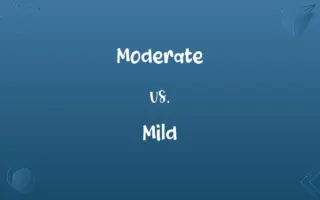Shear Stress vs. Tensile Stress: Know the Difference

By Shumaila Saeed || Published on January 5, 2024
Shear stress occurs when forces are applied parallel to a material's surface, causing layers to slide past each other, while tensile stress happens when forces stretch a material, pulling it apart.

Key Differences
Shear stress is characterized by forces acting parallel to the material's surface, leading to a sliding motion between different layers of the material. In contrast, tensile stress is defined by forces pulling on the material from opposite ends, resulting in stretching or elongation. Both stresses are crucial in understanding material deformation under different load conditions.
Shumaila Saeed
Jan 05, 2024
In shear stress, the deformation is caused by the relative motion between the layers of the material, often leading to a change in shape without a change in volume. Tensile stress, on the other hand, causes materials to elongate and potentially become thinner, impacting both the shape and volume. Both types of stress are pivotal in determining a material's strength and ductility.
Shumaila Saeed
Jan 05, 2024
Shear stress is commonly observed in materials subjected to cutting or torsional forces, where the layers or particles within the material slide over one another. Tensile stress is experienced in scenarios like pulling a rope or stretching a rubber band, where the material is under a uniaxial stretch. Both stresses help in assessing a material's resistance to different types of forces.
Shumaila Saeed
Jan 05, 2024
The failure mechanisms under shear and tensile stress also differ. Materials under shear stress often fail by sliding or shearing off along the plane of the applied force, while tensile stress can lead to a material's fracture or necking. Understanding both types of stress is crucial for designing safe and efficient structures and components.
Shumaila Saeed
Jan 05, 2024
Shear stress is often measured by the force per unit area parallel to the cross-section, while tensile stress is quantified as the force per unit area perpendicular to the cross-section. These measurements are fundamental in material science and engineering, aiding in the selection of appropriate materials for specific applications based on their response to shear and tensile stresses.
Shumaila Saeed
Jan 05, 2024
ADVERTISEMENT
Comparison Chart
Direction of Force
Forces act parallel to the material's surface.
Forces act perpendicular, pulling the material apart.
Shumaila Saeed
Jan 05, 2024
Type of Deformation
Causes layers to slide past each other.
Causes material to stretch or elongate.
Shumaila Saeed
Jan 05, 2024
Common Applications
Cutting, torsion in shafts.
Pulling ropes, stretching bands.
Shumaila Saeed
Jan 05, 2024
Measurement
Force per unit area parallel to the cross-section.
Force per unit area perpendicular to the cross-section.
Shumaila Saeed
Jan 05, 2024
Failure Mechanism
Material fails by sliding/shearing off.
Material fails by fracturing or necking.
Shumaila Saeed
Jan 05, 2024
ADVERTISEMENT
Shear Stress and Tensile Stress Definitions
Shear Stress
Shear stress is the internal resistance offered by a material when subjected to parallel forces.
Shear stress in the metal determines its ability to withstand sideways cutting forces.
Shumaila Saeed
Dec 18, 2023
Tensile Stress
Tensile stress occurs when forces pull on a material from opposite ends.
The tensile stress on a bridge's cables is crucial for maintaining its structure.
Shumaila Saeed
Dec 18, 2023
Shear Stress
Shear stress describes the deformation of materials under parallel forces.
In geology, shear stress explains how rocks deform under tectonic forces.
Shumaila Saeed
Dec 18, 2023
Tensile Stress
Tensile stress describes the elongation and potential thinning of materials under pulling forces.
The tensile stress in a rope determines how much load it can safely support.
Shumaila Saeed
Dec 18, 2023
Shear Stress
Shear stress is the stress caused by forces applied parallel to a surface.
The shear stress in a beam increases when a greater load is applied sideways.
Shumaila Saeed
Dec 18, 2023
ADVERTISEMENT
Tensile Stress
Tensile stress assesses a material's resistance to breaking under tension.
Engineers test the tensile stress of steel to ensure it is suitable for construction.
Shumaila Saeed
Dec 18, 2023
Shear Stress
Shear stress occurs when adjacent layers in a material move in opposite directions.
The layers of a deck of cards experience shear stress when the top is moved sideways.
Shumaila Saeed
Dec 18, 2023
Tensile Stress
Tensile stress is the measure of stretching force per unit area within a material.
Tensile stress in rubber determines how far it can stretch before breaking.
Shumaila Saeed
Dec 18, 2023
Shear Stress
Shear stress is a measure of force per unit area along a plane within a material.
Engineers calculate the shear stress in a bolt to ensure it can hold components securely.
Shumaila Saeed
Dec 18, 2023
Tensile Stress
Tensile stress is the stress experienced by a material when it is stretched.
The tensile stress in a cable increases as more weight is hung from it.
Shumaila Saeed
Dec 18, 2023
Repeatedly Asked Queries
Where is shear stress commonly found?
Shear stress is common in materials under cutting or torsional forces.
Shumaila Saeed
Jan 05, 2024
How do you measure shear stress?
Shear stress is measured as force per unit area parallel to the material's cross-section.
Shumaila Saeed
Jan 05, 2024
What is shear stress?
Shear stress is the force per unit area acting parallel to the material's surface, causing layers to slide.
Shumaila Saeed
Jan 05, 2024
What are typical applications of tensile stress?
Tensile stress applications include ropes under tension and stretching materials.
Shumaila Saeed
Jan 05, 2024
What units are used for tensile stress?
Tensile stress is measured in units like Pascals (Pa), indicating force per unit area perpendicular to the section.
Shumaila Saeed
Jan 05, 2024
What happens to materials under tensile stress?
Under tensile stress, materials can elongate, thin out, and potentially break.
Shumaila Saeed
Jan 05, 2024
Is shear stress relevant in earthquake engineering?
Yes, shear stress is critical in earthquake engineering for understanding ground and structural responses.
Shumaila Saeed
Jan 05, 2024
How is tensile stress defined?
Tensile stress is the force per unit area stretching a material, pulling it apart.
Shumaila Saeed
Jan 05, 2024
Are shear and tensile stresses always separate?
While distinct, shear and tensile stresses can occur simultaneously in complex loading scenarios.
Shumaila Saeed
Jan 05, 2024
Can tensile stress be beneficial?
Yes, controlled tensile stress can strengthen materials like metals through processes like tempering.
Shumaila Saeed
Jan 05, 2024
What role does shear stress play in geology?
In geology, shear stress explains rock deformation and movement along fault lines.
Shumaila Saeed
Jan 05, 2024
Can shear stress cause material failure?
Yes, shear stress can lead to material failure by sliding or shearing along the force plane.
Shumaila Saeed
Jan 05, 2024
How does tensile stress affect metal?
Tensile stress can cause metals to elongate, potentially leading to necking or fracture.
Shumaila Saeed
Jan 05, 2024
How does temperature affect shear stress?
Temperature can affect shear stress by changing the material's internal structure and resistance.
Shumaila Saeed
Jan 05, 2024
What tools measure shear stress?
Shear stress is measured using devices like shearometers or strain gauges.
Shumaila Saeed
Jan 05, 2024
Why is understanding tensile stress crucial in design?
Understanding tensile stress is crucial for ensuring materials withstand stretching forces in design applications.
Shumaila Saeed
Jan 05, 2024
Do fluids experience shear stress?
Yes, fluids can experience shear stress, particularly when flowing or under applied external forces.
Shumaila Saeed
Jan 05, 2024
Can tensile stress be applied to all materials?
Tensile stress can be applied to most materials, but their response varies based on ductility and strength.
Shumaila Saeed
Jan 05, 2024
Does tensile stress impact the volume of a material?
Tensile stress can change a material's volume, typically causing elongation and thinning.
Shumaila Saeed
Jan 05, 2024
Why is tensile stress important in bridges?
Tensile stress is vital in bridges to ensure cables and structures withstand stretching loads.
Shumaila Saeed
Jan 05, 2024
Share this page
Link for your blog / website
HTML
Link to share via messenger
About Author
Written by
Shumaila SaeedShumaila Saeed, an expert content creator with 6 years of experience, specializes in distilling complex topics into easily digestible comparisons, shining a light on the nuances that both inform and educate readers with clarity and accuracy.































































